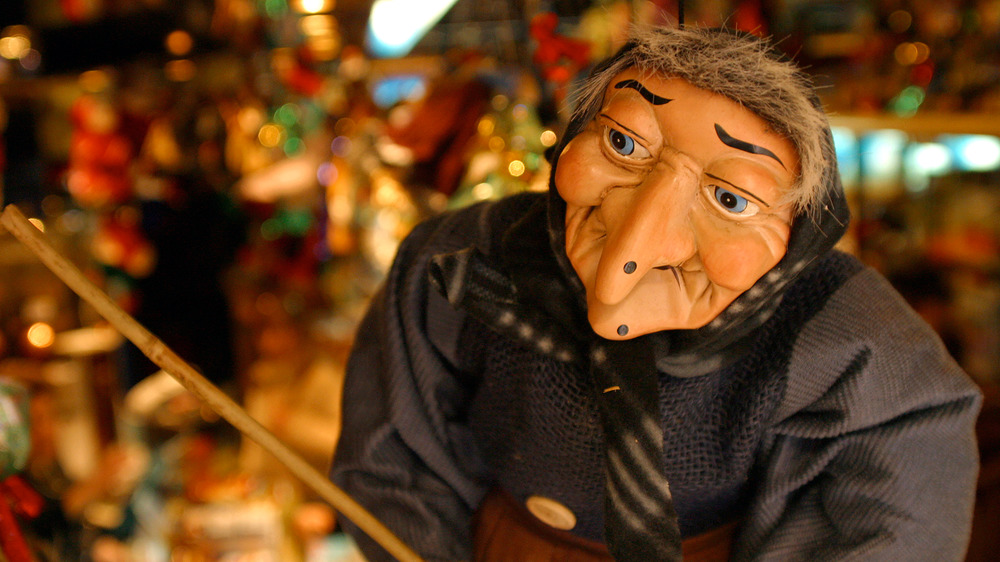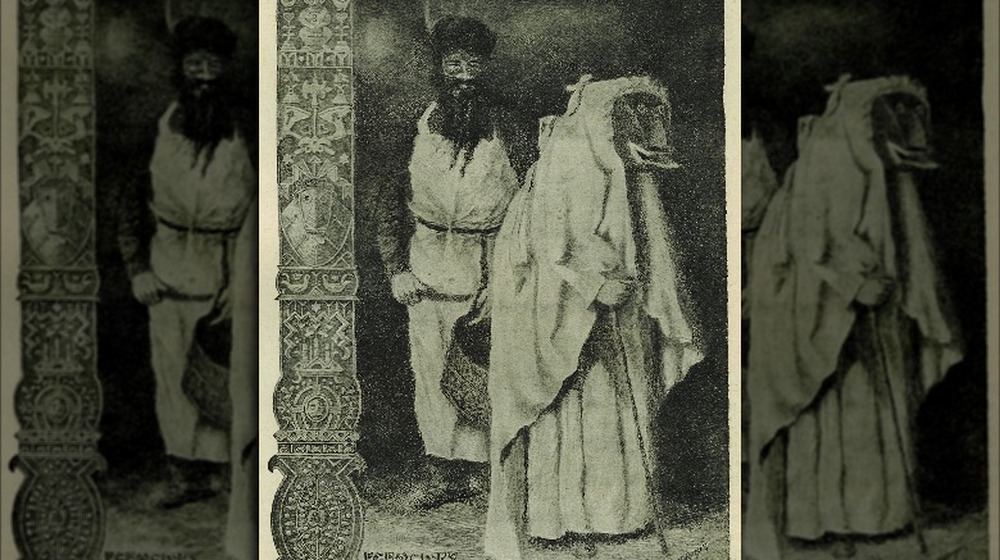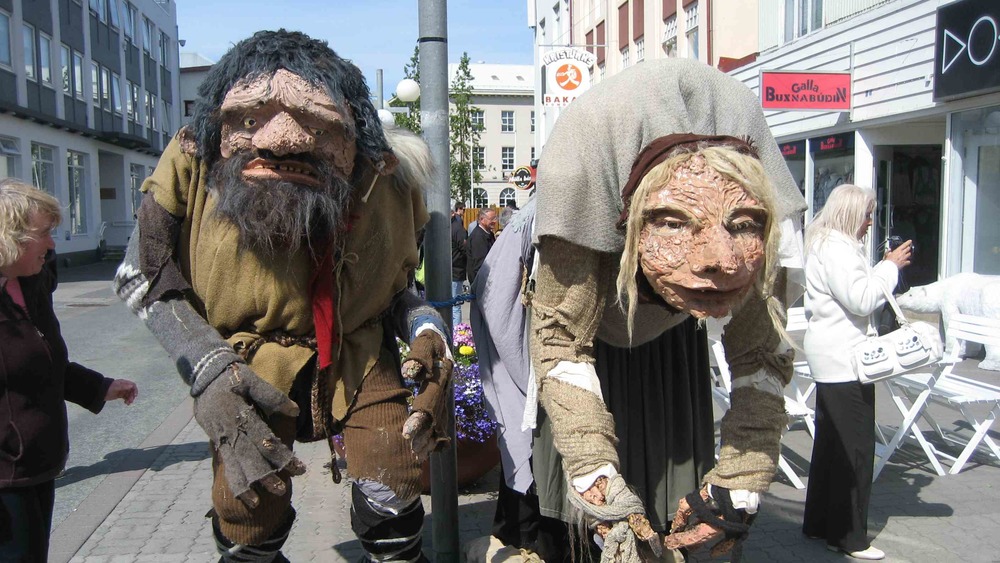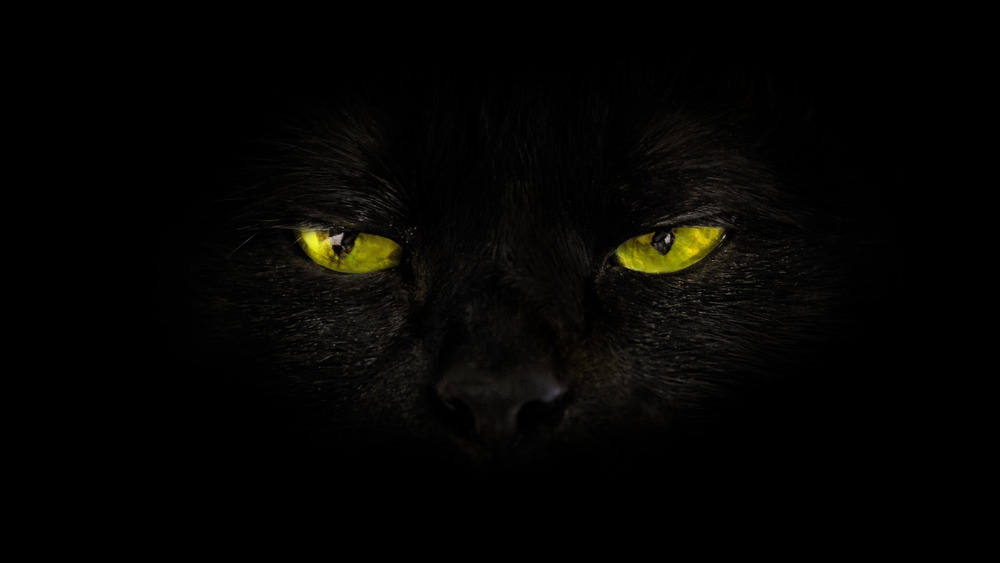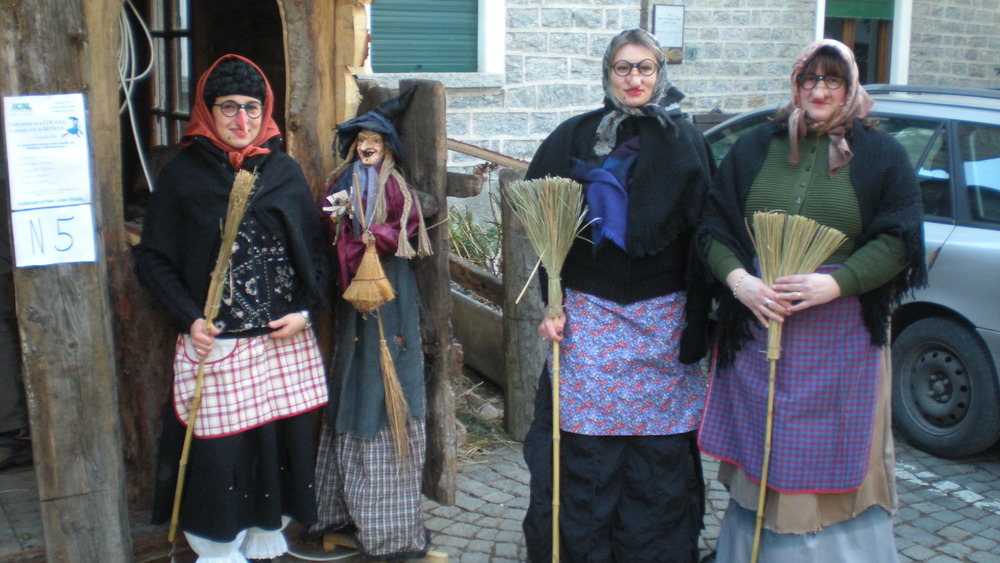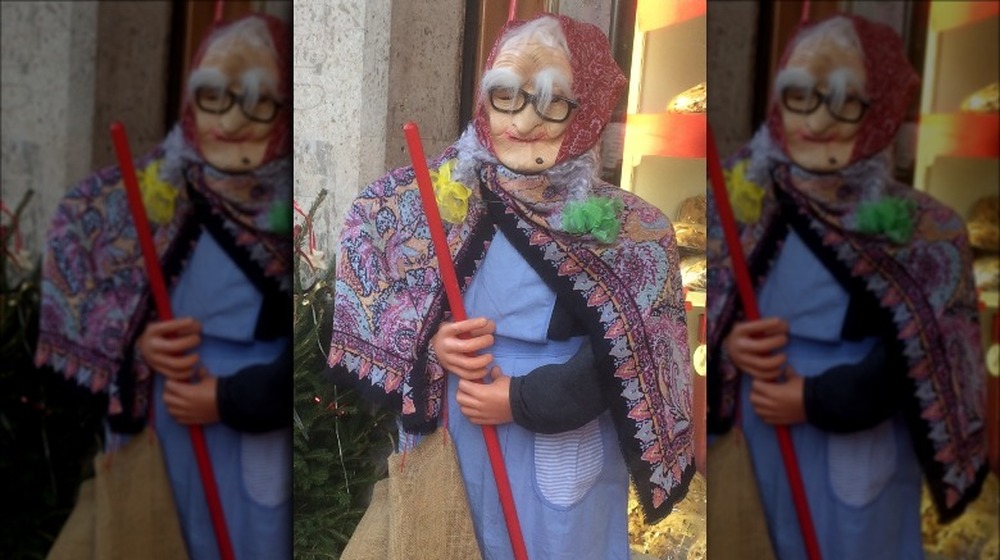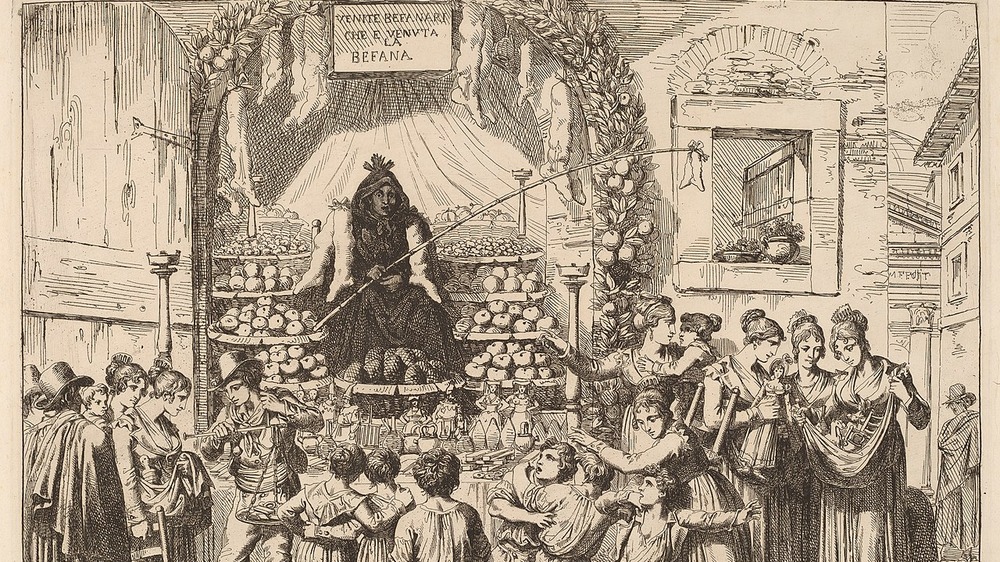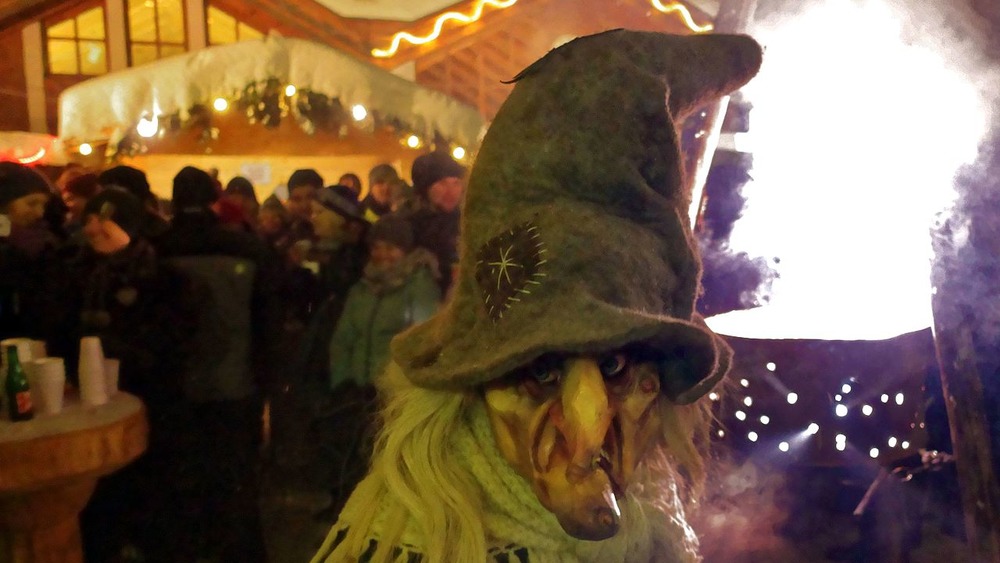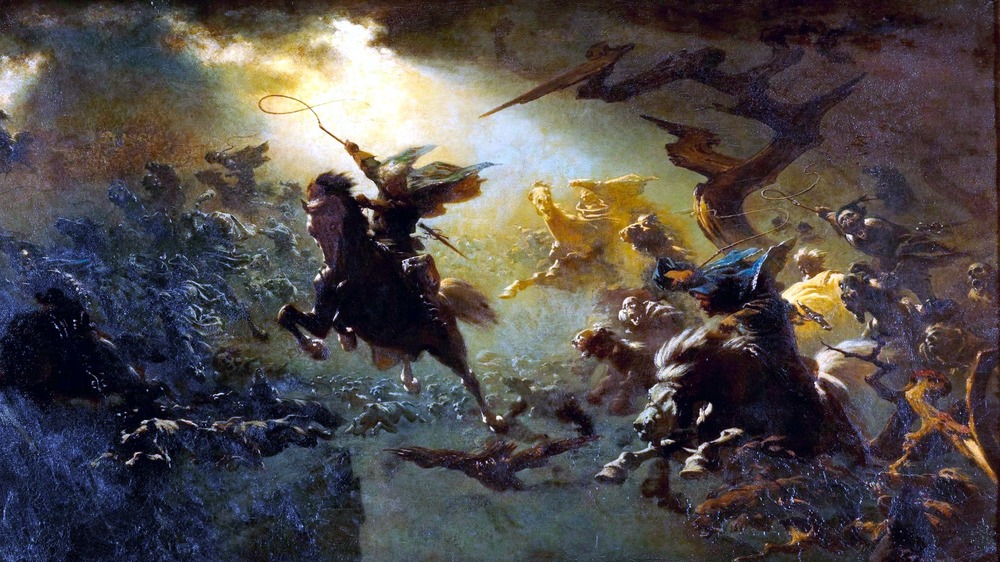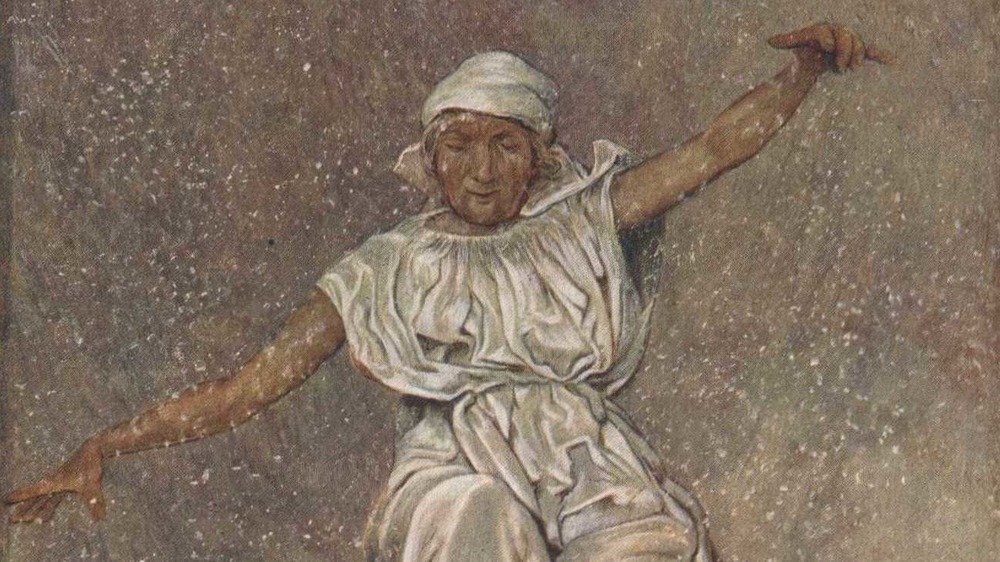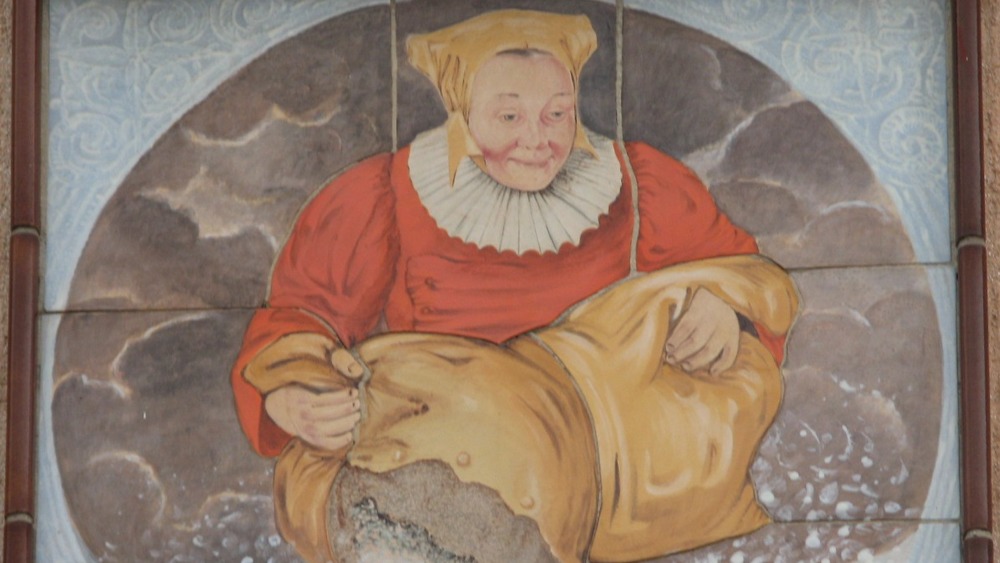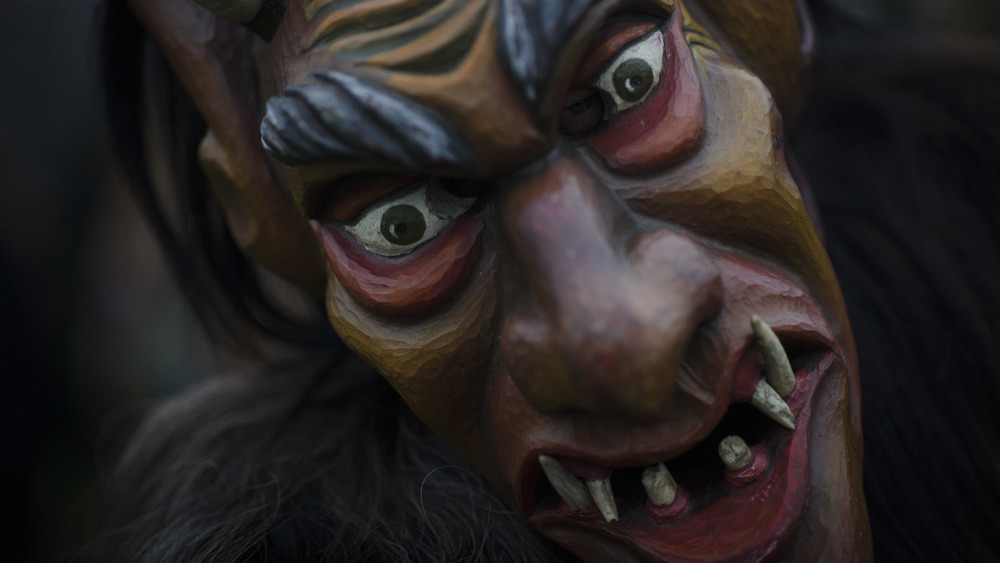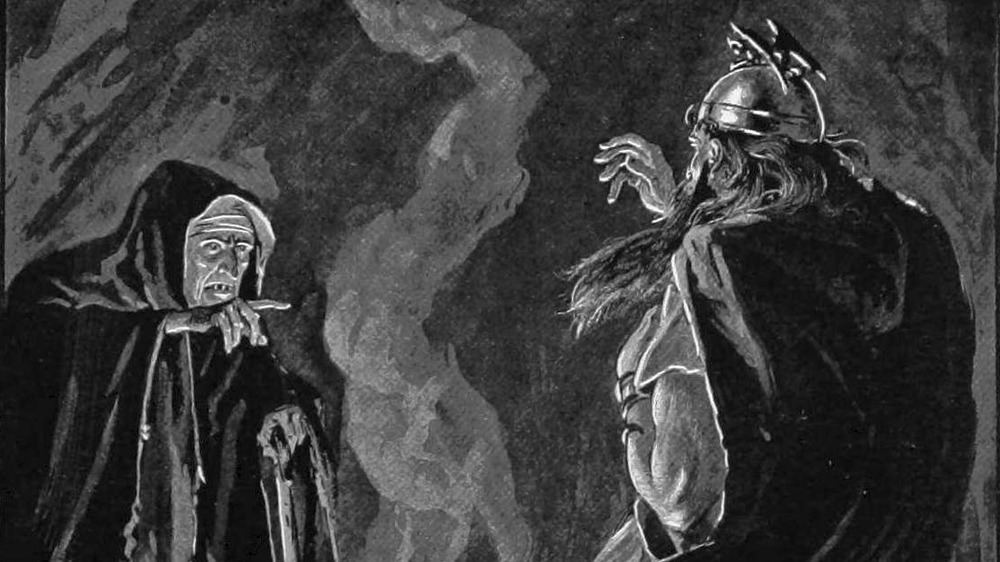The Untold Truth Of Christmas Witches
For those of us who live north of the equator, Christmas and the holiday season typically fall during a cold time of year, when we most want to gather and celebrate in defiance of the frosty weather and quickly setting sun.
But, there's a darker side to this season. The night is long and dark. The temperatures have dropped. At some point, you will have to leave the party and go outside, even if for only a brief moment. Then, you may realize just how thin that line is between the dark and the light, the warm and the cold. Sometimes, it's only a door or a winter jacket that's separating you from the icy chill.
Perhaps that's why, for every Christmas tale of Santa Claus and gifts under a tree, there's another one with mischievous goblins and even straight-up demons. Consider the Krampus, a ghastly, goat-like Alpine figure that smacks naughty kids with birch branches, stuffs them in a sack, and takes them back to Hell.
Krampus doesn't work alone, however. There are a whole bevy of holiday-themed ghouls, including an eye-catching subset of Christmas witches. These female figures run the gamut, from friendly grandmas who tell you like it is, to ogresses who descend from the mountains to gobble up whiny children, to wild, pre-Christian goddesses. Their legends have as much to say about Christmas and the rest of the holiday season as any jolly old elf. Part of that message? Watch yourself and mind the dark.
Christmas witches are linked to a pagan past
The roots of quite a few Christmas traditions are linked to older pagan practices that had been around for centuries by the time Christian monks rolled into town. The figures of Christmas witches like Iceland's Grýla or Italy's Befana are, in the minds of numerous scholars, linked to the same history, especially considering the female spirits and deities that appear in the old beliefs.
The journal Folklore argues just that, saying that the neutered modern traditions of Christmas witches can draw a lineage from older, more ferocious goddesses like Perchta and Holda. These figures reigned over the icy cold months that descended upon Europe. Folk would leave out offerings of food and frantically clean their houses. Frau Holle, a later version of Holda, was also said to have power over the weather. She caused the snow to fall whenever she shook out her feather pillows.
How to know that belief in these pagan goddesses was real? For one, monks throughout the continent loved to complain about them. According to The German Quarterly, Martin Luther, the former monk who kickstarted the Protestant Reformation, complained of the people's belief in Holda. He even went so far as to really lay into her characterization as an ugly old woman, just to make his point that she was bad news. Meanwhile, a medieval English monk named Bede spoke more vaguely of a heathen "mother's night" in The Reckoning of Time, held on December 25.
Iceland's Christmas witch wields a knife to terrorize bad children
The people of Iceland have their own Christmas witch who, during some periods of the country's history, has had a lot more in common with powerful pagan spirits than the downright cuddly Christmas magic-makers of today. At the center of that terrifying tradition is a dark figure known as Grýla.
Smithsonian Magazine reports that Grýla is traditionally understood to be a fearsome ogress who lives in the desolate mountains of Iceland. She descends from her home to snatch up misbehaving children, whereupon she throws them into a sack and takes them back to her abode. There, the naughty children are turned into stew. Or, in some other versions of the tale, she simply carves out their stomachs. Some modernized versions have softened her rough edges somewhat, though others are perfectly happy to keep Grýla in her eerie place in Icelandic lore.
According to the Proceedings of the Harvard Celtic Colloquium, legends of the Faroe Islands warn that Grýla will descend upon homes with her knife or short sword. She looks to punish children who whined and cried about missing meat during the season of Lent, when many faithful families went without such luxuries. Parents presumably let many children decide for themselves what Grýla did next with her knife.
Gryla has a terrible family
Grýla doesn't work alone. Like all high-achieving monsters, she has a team of fellow evil beings helping her to strike fear in the heart of Icelanders throughout the holiday season. Icelandic Folktales and Legends says that she has a husband, Leppa-Ludi. He also happens to be a cannibal who eagerly awaits the child-heavy meals Grýla prepares. Other legends also have Grýla disposing of her inconvenient husband, or else having multiple ones in succession, so perhaps Leppa-Ludi should step carefully.
Like many an ogress witch, Grýla also has children. In her case, that would be the sometimes mischievous, sometimes menacing Yule Lads. According to Smithsonian Magazine, the 13 Yule Lads were originally their own thing but got tied up with Grýla's family sometime in the early 19th century. That's also when Grýla appears to have adopted the Yule Cat, yet another terrifying Icelandic holiday figure who specializes in abducting people who haven't been given new clothes on Christmas.
The menace of the Yule Lads has been pulled back somewhat in recent times, says Smithsonian Magazine, but their origins show a dark side. Some mess with the livestock, others raid the pantry, one slams doors, and another simply likes to lick all of the spoons in the house. The creepy tales got so bad that, in 1746, Icelandic parents were officially banned from frightening their children with tales of the Yule Lads, Grýla, and the rest of her ilk.
La Befana brings down Christmas justice to Italian children
Compared to some of the more bloodthirsty witches ringing in the holiday season, Italy's La Befana can seem downright cuddly. Don't let that fool you. Befana still has some tricks up her sleeve.
Like many of her fellow Christmas witches, Vice reports, Befana has links to earlier, more definitely pagan practices. In her case, Befana may be a cultural descendant of Strenia, a Roman goddess who helped to ring in a new year. The Encyclopedia of Wicca and Witchcraft claims that she might also be a mythical ancestor figure who returns at the same time every year. She's also said to fly in on a broom or ride on a goat, like legends of older figures. Her haglike appearance may also link her to a legendary, very witchy "crone" image.
In more modern times, she prefers to act on a more personal basis. Good kids have nothing to fear and, in fact, may expect a bit of candy from Befana as a reward for exemplary behavior. Children who've indulged in bad behavior, however, have more to fear. In some versions of her legend, Befana will swoop down, stuff the ill-behaved brats into a sack, and take them home to her cannibalistic husband. Modern retellings have softened this shocking behavior, with bad children simply getting coal instead. More confusingly, some may even get sugar candy made to look like coal. Either way, she isn't afraid to tell it like it is.
The witch Befana has a nicer side
Other versions of Befana's story claim that she has a kinder side. She's even connected to overtly Christian stories. According to Vice, one tale has the Three Wise Men staying over at her home while they travel to see the newborn Jesus. Being a busy woman, she declines to accompany them. Befana then rethinks her decision and hurries along to the legendary manger, gifts in hand. A sadder version has her grieving a lost baby, even deliriously thinking the infant Jesus is her own offspring. Jesus loves her gifts and makes the grief-stricken woman the mother and protector of all Italian children.
While other Christmas witches get pretty salty if a home isn't clean, Italy Magazine says that Befana is more willing to lend a helping hand. In Befana's case, she's rumored to sweep the floors of every house she visits. The holiday season gets pretty busy, after all, and so why shouldn't a harried parent get an assist? Maybe Befana can have a word with some of the other, more vicious Christmas witches about loosening up a bit.
Befana is so beloved that Italians hold festivals in her honor
While other Christmas witches are downright terrifying, Befana's softer side has really boosted her public image. She's become such a popular fixture of Italian folklore that she now has multiple holiday markets and festivals honoring her every year.
TripSavvy reports that Urbania holds a whopping four-day festival for their Christmas witch, held from January 2-6. Kids can even be told they're visiting Befana herself as they meet an actor playing her in the La Casa Della Befana. Of course, there are also plenty of market stalls filled with toys, treats, and the now ubiquitous sugar candy formed to look like coal.
Urbania's festival may be one of the biggest celebrations of La Befana in Italy, but it's not the only one. According to iItaly, Venice holds a Befana Regatta, or a boat race wherein people dressed up as haggard old witches zoom through the city's famous Grand Canal. The New York Times reports that Rome also has its own Befana market, though it's been plagued by security concerns in recent years. Still, Italian families are clearly keeping the legend of La Befana alive in their own homes, year after year, from handing out coal candy to hanging up stockings for the powerful Christmas witch.
Frau Perchta is an Austrian Christmas witch with a vendetta
As a group, the various witches and goddesses associated with Christmas today seem to have some serious, long-lasting vendettas. Befana and Grýla bring the hurt down on bad children, while older deities and spirits like Holda are prepared to bring down snow and cold at their leisure.
Frau Perchta, of Austrian and southern German lore, isn't too different. According to the journal Folklore, she's generally thought to be at her most prominent during the 12 Days of Christmas, which run from December 25 to January 5. Frau Perchta roams her lands, looking for people who have slacked off during the season. Any homes found to be dirty or out of order might then be subject to a visit from this terrifying figure.
In the darkest versions of her legend, Frau Perchta doesn't play around, Vice reports. Lazy housekeepers and sassy children get their stomachs cut open and innards replaced with garbage by the vengeful Christmas witch. Good kids and industrious folk might find a small coin or other treat hidden in their homes, though they may have simply been grateful not to meet a worse fate at the end of Frau Perchta's sharp knife. More sedate legends say that mountain shepherds have seen her wandering the slopes with a spindle and spinning fiber in her hands. At least Frau Perchta seems to practice the kind of industriousness she preaches.
Perchta is linked to the legend of the Wild Hunt
Legend says that the Wild Hunt is a ghostly group who goes out "soul-raving" across the countryside, often led by illustrious or infamous figures. According to the Journal of Mythic Arts, these could include local heroes, dead kings, the old Norse god Odin, or, in less subtle retellings, simply the Devil. Anyone who encountered the Wild Hunt was in serious trouble. They might be swept up in the horde, which could be as purgatorial as it was potentially fun. No one's witnessed the Wild Hunt taking a break, after all.
In Germany, We Are Star Stuff says, this leader was sometimes identified as Perchta or another witchy figure called Holda. Some Alpine towns still celebrate a tradition known as Perchtenlauf, in which masked figures connected to the legends of Perchta and the Wild Hunt tramp through town, generally making noise and enacting mischief. Their wild ramblings are said to be connected to this older legend of the much more destructive, scary troop led by Perchta in her more spiritual, divine incarnation. Like other ancient goddesses, Perchta and Holda demanded respect and often elicited quite a bit of fear, too.
In Slovenia, similar groups could be led by Baba, whom the Institute for Slovenian Studies of Victoria says is a haglike goddess of death. Folklore also notes that Frau Holle, a more domestic version of Holda, has also been spotted at the fore of the Wild Hunt.
Nobody messes with the Christmas witch called Frau Holle
Frau Holle is also known as the "Dark Grandmother" and "White Lady" and is said to reward industrious folk and punish the lazy. The journal Folklore says that she can get pretty nasty to lazy housewives, especially if they've been slacking on the spinning. In the Franconia region of Germany, she even goes so far as to smear her own excrement on unspun flax, making for a particularly unpleasant morning for whoever finds Frau Holle's leavings.
Other legends make the right path very confusing, as some regions say that all spinning actually has to stop by Epiphany, or January 6, lest overly industrious folk bring down the wrath of Frau Holle. If you manage to figure out what exactly Holle wants from you, then you may be given the gift of a small coin or a good year ahead.
The Witch also points out the prevalence of traditions like leaving food out for the roving Frau Holle. Yet again, something is known of this tradition because of the numerous religious sources out there complaining about these lingering pagan practices.
The legend of Holda is linked to Christmas celebrations
One of the oldest winter witches is Holda, who's linked to ancient Germanic goddesses who had distinct and eerie links to the spirit world. In many tales, Mother Holda, as she's sometimes known, is even surrounded by a whole retinue of ghosts. Norse Goddess Magic maintains that she was originally a sky goddess who had control over the weather. Her various household routines were linked to the weather, with fluffy white clouds being her linen hung out to dry and rain the result of her washing. Legend says that she even introduced flax to our species, showing peasants how to take the plant fiber and spin it into linen thread.
In a more touching turn, Holda is also said to take care of the ghosts of the dead, especially young and unborn children. She may also be in charge of introducing new ones into the world, as some stories say that babies come from her well or pool, indicating a link with older beliefs in rebirth.
The journal Indogermanische Forschungen says that Holda, despite or perhaps because of her earlier pagan association, is linked to the winter holidays. One source said that "On the night of Christ's nativity, they set [a place at the table] for the queen of heaven, whom the people call Mistress Holda." Doing so was hoped to bring good luck and health to the household for the coming year.
Many Christmas witches are ugly for a reason
Quite a few Christmas witches are portrayed as ugly old women, from Befana's hunchback to Perchta's downright demonic appearance. A few different explanations have been offered up over the years. They could be linked to the time of year, growing old and craggy as the year itself ages. Or, as Norse Goddess Magic proposes, the figure of a crone may be linked to the wild nature of some of these Christmas witches, especially if talking about their older, more pagan forms.
Christmas witches might also have become ugly in legend as a way to scare off the bitter cold of winter, Vice says. Who better to frighten away the terrible winter weather than an equally frightful and powerful witch? Perhaps it's no coincidence that many of them are associated with the holidays, which generally fall around the winter solstice and mark the return of the sun and warmth to the world.
Not all Christmas witches are hard to look at, however. Some versions of Perchta are actually quite beautiful, especially in her more overtly godlike incarnations. As per Folklore, figures like Frau Holle and Perchta could be regal and awe-inspiring, clad in beautiful white clothes and dispensing good fortune as much as bad.
Scottish families fear the gyre-carling witch in winter
Though many legends of Christmas witches seem to center on the European continent, don't think that you can escape the horror of their wrath simply by moving. Over in Scotland, they have their very own holiday-associated witch who's ready to wreak havoc with her iron club if a house isn't in order. Her name is the gyre-carling. She's so well-known and feared that, as Studies in Scottish Literature points out, her fearsome reputation has been entrenched in literature forevermore.
Folklore says that the gyre-carling, like many other Christmas witches, is a hideous ogress who is also "long-nebbed," or blessed with a remarkably long nose. People who annoyed her by leaving flax unspun might find it missing in the morning. Worse, the gyre-carling could decide to clobber them in the heel with her iron club. She might even try her own hand at spinning if the wheel hadn't been put away properly, surely frightening the poor family who forgot to finish this task.
